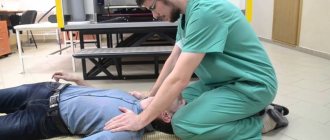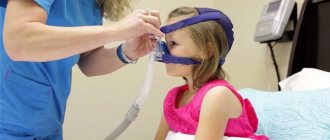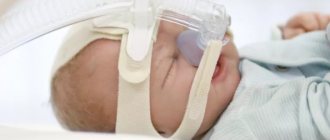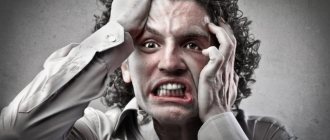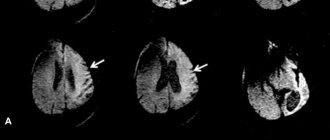The Moscow mental health center “Leto” provides a full range of techniques for identifying and treating psychoneurological diseases. To do this, we use modern equipment and drugs with minimal side effects. Our doctors have a high level of theoretical training and rich practical experience. If you or your relatives have night sleep epilepsy, then by contacting our clinic, you will receive qualified help and get rid of the manifestations of the disease. Not only residents of Moscow, but also representatives of other regions and citizens of other countries come to us for treatment. We try to help all people in need of healing and find an individual approach to each client. Those who have undergone treatment leave positive reviews and, if necessary, contact us again.
What is the difference between epilepsy at night?
Attacks in adults are less severe compared to daytime episodes. Convulsions are completely absent, or are expressed smoothed out in the form of chaotic oscillatory movements of the arms and legs. This circumstance is explained by the low activity of the central nervous system at night. During this period of the day, the human brain reacts minimally to incoming external and internal stimuli.
The clinical classification of paroxysmal manifestations takes into account the sleep phase.
So the following variants of epileptic seizures are distinguished:
- Early. Occurs within the first 2 hours after
the man falls asleep. - Pre-dawn. Before waking up, basic functions in the brain begin to activate and against this background, manifestations of the disease may develop.
- Morning. Characteristic of cases of forced awakening (alarm clock, phone call, physical impact, voice).
Daytime sleep attacks can also be included in this group.
Knowing these features, the medical staff of the Leto clinic monitors clients with this pathology most carefully in order to prevent possible complications.
Patient's behavior during an attack (non-epileptic psychogenic, conversion)
The behavior of such patients is characterized by excessive dramatization and hypochondriasis towards their own condition and the world around them.
Clinical picture during an attack
The clinical picture of psychogenic epileptic seizures does not have pathognomonic symptoms, which is why their diagnosis is difficult even for experienced epileptologists. Externally, they imitate generalized or focal seizures in epilepsy.
Classification of attacks
Scientists around the world have repeatedly tried to classify seizures into certain groups, but the following classifications are most widespread:
T. Betts and S. Boden in 1992 characterized various groups of pseudoseizures as “syncope,” “temper tantrum,” and “arreactive type.”
- “fainting” is characterized by the development of general weakness of the whole body, a sharp fall without loss of consciousness. Patients lie with their eyes closed, breathe heavily, and no convulsions are observed. The attack ends with an extremely rapid restoration of an adequate state;
- “outbursts of anger” are accompanied by screaming, crying, aggressive behavior of the patient (they bite, fight), the attack is short-lived and quickly stops on its own;
- The “unresponsive type” is characterized by tension of the whole body with an elaborate arching of the body, swaying movements of the torso (usually the pelvis), holding the breath and groans of the patient. The most common time for such attacks to occur is at night.
Patients with psychogenic non-epileptic seizures truly suffer and experience discomfort; the seizures are real, felt by patients as true, but are not epileptic. Therefore, a different type of treatment than for epilepsy is required.
G. Groppel in 2000 proposed his own classification based on clinical manifestations and divided them into clusters:
- “psychogenic motor seizures” - most similar to a typical clonic-tonic seizure in epilepsy - trembling of the limbs, torso and clonic movements of the head;
- “psychogenic small motor seizures” - characterized by active movements of the arms and/or legs;
- “psychogenic atonic attacks” - complete relaxation of muscles with a sharp fall to the floor.
Despite the rather complex diagnosis, it is possible to suspect psychogenic non-epileptic seizures.
Repeated studies have revealed features characteristic of pseudo-seizures. The patient's medical history recorded:
- extremely frequent seizures (several times a day on most days of the year) in the absence of any neurological deficit,
- lack of effect from anticonvulsant therapy (in some cases, even a paradoxical increase in the number of attacks while taking them),
- provocation of attacks against the background of psychotraumatic situations (stress, conflicts, fatigue),
- absence of any injuries or damage from attacks (bruises, hematomas, burns, etc.),
- the absence of pathological brain activity or the presence of changes non-specific for epilepsy on repeated EEGs over time.
Symptoms before the attack
1) Preictal features of PNEP (features preceding the onset of an attack):
are never recorded during sleep (unlike true epilepsy) - when recording video-EEG monitoring, patients outwardly resemble normal sleep, but the rhythm of wakefulness is recorded on the tape, and attacks most often occur in the presence of witnesses.
2) Ictal features of PNEP (features accompanying the attack itself):
- patients assume pretentious poses;
- movements are asynchronous and often change during the attack;
- extremely often accompanied by excessive vocal activity: crying, moaning, screaming, etc.;
- protective behavior during an attack (preventing injuries, following some instructions from others);
- closing the eyes and resisting the lifting of the eyelids.
In general, the duration of the attack is much longer than a normal epileptic seizure (however, a short-term attack cannot exclude PNEP).
That is why the gold standard for examining patients is EEG monitoring of wakefulness and sleep with recording of clinical events.
and you can sign up for the study by calling: +7
3) Postictal features of PNEP (features characteristic of the period after the end of the attack):
- fairly rapid normalization of the condition after an attack,
- absence of episodes of memory loss at the beginning of the attack.
It is worth noting once again that patients with psychogenic non-epileptic seizures do not feign seizures, they are real, felt by patients as true.
Diagnosis of attacks
- Diagnosis of pseudoseizures is a long, multi-stage process that requires a multidisciplinary approach.
- When making a diagnosis, the participation of a neurologist and psychiatrist is mandatory.
- Diagnosis of psychogenic non-epileptic seizures (conversion) is based on excluding the diagnosis of true epilepsy (primary or symptomatic).
That is why the gold standard for examining patients is long-term video-EEG monitoring, often repeated and over time.
According to the results of the EEG, no pathologies are usually noted; in some cases, some types of dysfunction are detected, but pathological bioelectrical activity is never noted.
Differential diagnosis of seizures
Differential diagnosis between epilepsy and non-epileptic seizures is extremely important, since patients with PNES are often prescribed ineffective anticonvulsant therapy.
Conducting video EEG monitoring of sleep and wakefulness followed by consultation with a competent neurologist (epileptologist), probably + MRI of the brain is extremely important. Since an incorrect diagnosis often does not result in treatment. The patient does not recover.
Such patients mistakenly find themselves in the group of patients with drug-resistant epilepsy and are subject to the prescription of aggressive doses of antiepileptic drugs with frequent development of undesirable side effects and lack of clinical effect.
Unfortunately, the current statistics are sad - on average, from the onset of the disease to the final correct diagnosis of PNEP, it takes 7-10 years.
Nocturnal attacks of epilepsy, manifestations
Paroxysm may have a convulsive component
Tom, and without him. The grand mal attack looks classic. It begins with a phase of the tonic component, in which the patient’s body and lower limbs are stretched, arms are pressed to the chest, muscles spasm, and breathing is impaired.
After about a minute, the clonic phase develops. The patient moves his limbs tensely and chaotically. The muscles of the neck and torso are in a contracted state. Breathing is hoarse, foam and blood may come out of the mouth, and sphincter disorders are observed. After a few minutes, the painful process subsides. An epileptic, as a rule, does not know and does not remember his attacks, especially those that occur in a dream.
Knowing about his illness, he independently identifies the signs of a seizure as a result of detecting:
- Rumpled and crumpled bed.
- Stains of blood and saliva.
- Traces of feces.
Sometimes before the onset of an epileptic attack, patients wake up with a feeling of fear, experience a sharp headache, nausea, and vomiting. Seizures can occur several times during the night.
Alcoholic epilepsy
Alcoholic epilepsy occurs in 2-5% of chronic alcoholics. This pathology is characterized by severe personality disorders. It occurs in adult patients who have suffered from alcoholism for more than 5 years.
The symptoms of the alcoholic form of the disease are very diverse. Initially, the patient experiences signs of an approaching attack. This happens several hours or even days before it starts. Precursors in this case can last a different amount of time, depending on the individual characteristics of the organism. However, if warning signs are detected in a timely manner, an attack can be prevented.
So, with the harbingers of an alcoholic epileptic seizure, as a rule, the following occur:
- insomnia, loss of appetite;
- headache, nausea;
- weakness, weakness, melancholy;
- soreness in various parts of the body.
Such warning signs are not the aura that represents the onset of an epileptic seizure.
The aura cannot be stopped, nor can the seizure that follows it. But the warning signs, detected in a timely manner, can be treated, thereby preventing the occurrence of attacks.
Causes of epilepsy at night
Why the symptoms of the disease appear during the dark period of the day still remains an open question. But based on practical observations, psychiatrists at our mental health center have identified a number of factors that provoke exacerbation.
These include:
- Insufficient duration of rest, chronic lack of sleep.
- A state of prolonged stress.
- Abuse of drinks containing alcohol, smoking.
- Taking psychoactive substances, including medications.
- Head injuries, previous surgical interventions.
- The presence of epilepsy in close relatives.
In a child, an attack can be triggered by:
- Overexcitement before falling asleep.
- Loud noise at night.
- Lack of fresh air.
- High or low temperature in the sleeping area.
- Violent awakening.
Similar causes leading to a seizure are also identified in adolescents. To these is added watching a movie in the evening that causes a mental reaction and excitement.
Diagnostics
If your loved ones, children, or acquaintances have suspicious symptoms, we suggest undergoing a diagnostic examination at our Leto clinic. Experienced specialists will assess the patient’s condition and accurately establish a diagnosis so that the subsequent selection of treatment will lead to a positive result.
To make an appointment with a doctor, make a preliminary call at the phone number listed on the website. The receptionist on duty will register the client at a suitable time.
The initial consultation includes:
- Survey and find out the essence of the problem that has arisen.
- Examination with assessment of all data on the condition, including neurological status, identifying signs characteristic of epilepsy.
- Clarification of all the details of existing epileptic attacks: frequency of occurrence, duration, other features.
After the medical examination you will need to undergo:
Magnetic resonance imaging (MRI). It will allow us to identify oncological processes, structural features of the brain, the presence of consequences of hemorrhages, vascular anomalies, and other changes that lead to problems.- Electroencephalography (EEG). Removal of biopotentials makes it possible to accurately identify the paroxysmal predisposition of the nervous system and establish the variant of the disease.
- Positron emission tomography (PET). The technique is prescribed to patients with metabolic and metabolic disorders in the body to assess metabolic processes in brain tissue, to confirm the found formations in controversial cases.
If the patient has concomitant ailments, the clinic can provide consultations with other specialists.
All procedures are necessary to clarify and confirm the diagnosis.
Classification of attacks
There are different types of night attacks:
- Frontal - they are characterized by dystonic manifestations on the limbs, hypermotor attacks, and vocal manifestations.
- Temporal - occurs with a complex combination of autonomous, automatic and psychological symptoms.
- Occipital with visual signs - they are characterized by eye movements, headaches and vomiting.
Most often, patients experience frontal attacks. Other species are less common. The type of seizures is determined by doctors during a thorough diagnosis.
Read about other types of the disease:
- epilepsy of Kozhevnikov and Jackson, rolandic and temporal forms;
- generalized and focal, myoclonic and partial;
- congenital and acquired, including alcoholic;
- absence, cryptogenic and pharmacoresistant.
Treatment
After consultation and examination, psychiatrists at the Leto clinic will offer you the most suitable treatment option. In uncomplicated cases, you can get by with an outpatient selection of the necessary medications to take at home. In more complex situations, hospitalization cannot be avoided.
We offer you comfortable conditions in our hospital rooms. 24-hour supervision allows you to use all treatment procedures with maximum efficiency.
The treatment plan is selected individually and includes:
Prescribing drugs to relieve pain from attacks in the presence of pain using anticonvulsants or painkillers, as well as taking prunes, which contain a lot of calcium. This element is able to reduce the number of convulsive episodes and has the ability to relieve pain.- Prevention and reduction of the frequency of new paroxysms. The goal is achieved by consuming foods that are part of the ketogenic diet.
- Reducing the duration of residual seizures.
- Gradually reduce the dose of medication after the seizures disappear.
Pharmaceutical drugs are selected in such a way as to minimize the possible side effects of anticonvulsants.
Nocturnal sleep epilepsy must be eliminated by prescribing special anticonvulsants. The selection of anticonvulsants begins with the selection of one name. If necessary, two or more pharmaceuticals are introduced into the treatment regimen.
Most often used:
- Carbamazepine.
- Clonazepam.
- Phenytoin.
- Lamotrigine.
If the selection and combination of pharmacotherapy does not give the expected result, then electrical stimulation of the vagus nerve is prescribed.
As an additional treatment option, the Vojta physiotherapeutic method is used, based on the normalization of nerve connections. This technique can be taught to the patient’s relatives, and they will be able to use it at home independently after discharge from the hospital.
Cost of services
| CONSULTATIONS OF SPECIALISTS | |
| Initial consultation with a psychiatrist (60 min.) | 6,000 rub. |
| Repeated consultation | 5,000 rub. |
| Consultation with a psychiatrist-narcologist (60 min.) | 5,000 rub. |
| Consultation with a psychologist | 3,500 rub. |
| Consultation with Gromova E.V. (50 minutes) | 12,000 rub. |
| PSYCHOTHERAPY | |
| Psychotherapy (session) | 7,000 rub. |
| Psychotherapy (5 sessions) | 30,000 rub. |
| Psychotherapy (10 sessions) | 60,000 rub. |
| Group psychotherapy (3-7 people) | 3,500 rub. |
| Psychotherapy session with E.V. Gromova (50 minutes) | 12,000 rub. |
| TREATMENT IN A HOSPITAL | |
| Ward for 4 persons | 10,000 rub./day |
| Ward for 3 persons | 13,000 rub./day |
| Ward 1 bed VIP | 23,000 rub./day |
| Individual post | 5,000 rub. |
| PETE | 15,000 rub./day |
This list does not contain all prices for services provided by our clinic. The full price list can be found on the “Prices” , or by calling: 8(969)060-93-93. Initial consultation is FREE!
Preventing seizures
Epileptic seizures that occur at night are easier for patients to tolerate. The effectiveness of drug therapy also gives more significant results. After treatment is completed at our mental health center, we offer patients recommendations to reduce the likelihood of symptoms returning.
Clients should adhere to the following rules:
Normalize sleep and rest patterns. Sleep at least 8 hours a day, go to bed and get up at a certain time.- Provide the opportunity to rest for at least 1 hour during the day.
- In the evening, do not watch TV for a long time, especially with programs and films that carry negative information.
- Do not play computer games or talk on the phone for a long time.
- Before going to bed, calm down and think about something pleasant.
- Sleep in a ventilated room with the curtains closed.
- Avoid drinking alcohol and smoking completely.
- Do moderate intensity physical activity. Strictly avoid overloading.
- If you have the slightest suspicion of resumption of epileptic seizures, consult a doctor immediately.
Basic forms
The most common forms of the disease in children include the following:
Seizures in sleep
When attacks occur during sleep, it can be clearly stated that the epithelial focus is located in the frontal lobes of the brain.
This form is considered the easiest and is easy to treat, but it can be lengthy and should be carried out under the supervision of a specialist.
Attacks can occur both during sleep and before waking up. They may be as follows:
- Parasomnias . They are shaking of the legs when falling asleep, appearing involuntarily and often combined with short-term disturbances in movement after the child wakes up.
- Walking and talking in your sleep (sleepwalking) along with urinary incontinence and nightmares.
If symptoms persist into adulthood, the disease may progress to more severe forms and may include aggressiveness upon awakening and self-harm.
Frontal
Frontal or frontal epilepsy may also involve seizures during sleep. Seizures start and end quickly. They can manifest themselves as muscle weakness. In a dream, a child can turn his head uncontrollably, rush about, and make sudden movements of his limbs.
The frontal lobe consists of a large number of parts, the functionality of which is not yet precisely known.
This means that when an attack begins, there may be no visible symptoms in these parts until it spreads to other areas or to a larger area of the brain.
This form is often accompanied by sharp emotional gestures that begin and end quickly and last at least a minute.
Focal
Focal epilepsy is a form that has locally determined causes and is accompanied by periodic seizures.
It is associated with increased electrical activity in some part of the brain.
The main symptom is seizures with convulsions or equivalent manifestations.
Their features will depend on the location and subtype of the disease.
Cryptogenic
This is a type of focal form in which the causes are unclear . The manifestations of cryptogenic epilepsy in this case are characteristic - the same seizures, but foci of increased activity cannot be detected.
Frontotemporal
With this form, it can be difficult to determine what the child is feeling at the time of the attack. Hallucinations may include voices, smells, and possibly tastes.
Convulsions can be either very minor or severe.
They can also be accompanied by certain vivid sensations: fear, pleasure, admiration and other emotions.
Benign
It occurs quite often and is a consequence of the formation of a focus of convulsive readiness in the nerve cells of the cerebral cortex.
Usually manifests itself between the ages of 2 and 14 years with rare and short convulsive seizures on one side of the face, as well as the tongue and pharynx. They occur most often at night.
Rolandic
This form is considered benign.
Attacks of Rolandic epilepsy do not involve loss of consciousness and are accompanied by tingling, tingling, or numbness on one side of the face or tongue.
This can affect speech, causing it to become distorted.
Tonic-clinical convulsions may also occur, which occur during sleep, falling asleep, or before waking up. Due to frequent seizures at night, the child may feel tired during the day.
Symptomatic
Symptomatic epilepsy occurs extremely rarely in children. It occurs against the background of an existing brain disease.
The root cause may be Down syndrome, metabolic disorders, tuberous sclerosis, neurofibromatosis and other pathologies.
Severe toxicosis during pregnancy, complications after vaccines, and poisoning of the body with toxins can also influence the formation of seizures.
Vesta
This syndrome is a fairly rare form, occurring in 2% of cases . Typical for boys at 4-6 months of age. Usually after three years this type transforms into others, for example, Lenox-Gastaut syndrome.
Characteristic manifestations of myoclonic convulsions develop over time into tonic or clonic and vice versa. They can occur before or after sleep, and it has not yet been determined when the seizures are more pronounced - in the daytime or in the evening.
Lennox-Gastaut syndrome
A rather rare manifestation, which is characterized by difficult-to-control seizures, mental retardation, and special signs are also noted on the EEG.
It usually appears between the ages of 1 and 6 years, but later manifestations are also possible.
A combination of tonic, atonic or astatic seizures, difficult to treat, as well as atypical absence seizures, is characteristic.
Febrile seizures
Febrile seizures can appear between 3 months and 6 years of age.
An attack can be triggered by any disease that can cause an increase in body temperature.
Manifestations may be accompanied by slight shaking, or complete convulsions of the whole body, and even loss of consciousness.
Juvenile myoclonic
It manifests itself as myoclonic jerks, which can be combined with tonic-clonic convulsions. Possible loss of consciousness, tension in the limbs and torso, and twitching. Symptoms of juvenile epilepsy appear before or after puberty.
Cramps most often make themselves felt in the morning, after waking up. Moreover, quite often they are provoked by various light sources. In this case they are called photosensitive. Children may have problems with abstract thinking and planning.
Infantile spasms
A rather rare variety that begins in newborns aged 2-12 months and ends at 2 years, but as a result can be replaced by other forms.
While lying on his back, the child may begin to sharply raise and bend his arms, raise his head and body, while simultaneously straightening his legs.
The seizure may last only a few seconds, but repeat throughout the day.
It is also possible to have psychomotor impairment or intellectual development delays that persist into adulthood.
Reflex
This syndrome involves the occurrence of attacks due to external stimuli - triggers. Quite often there is a photosensitive form - a reaction to light flashes.
Triggers can also be sharp loud sounds, or internal triggers: strong feelings and emotions and other thought processes can provoke an attack in a child.

